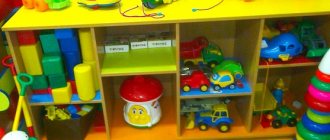Dressing
Preschoolers are taught to independently monitor their appearance, adjust their collar in a timely manner, tuck their shirt into their trousers, and comb their hair.
In the summary of the regime moment “Dressing” in the senior group, you can indicate the following tasks:
- Cultivate a caring attitude towards your things and neatness.
- Reinforce the correct dressing algorithm.
- Improve skills in fastening buttons, zippers, and tying shoelaces.
- Repeat the name and purpose of clothing, color, the concepts of “left” and “right”.
Before getting ready for a walk, the teacher and the children tidy up the group and put the toys in their places. Each child gets dressed near their locker. It is important that pupils do not throw their clothes around, carefully fold their things, and put away their spare shoes. In winter, you can hang in a visible place the algorithm for dressing and undressing in pictures. If necessary, individual work is carried out with children, practical techniques are demonstrated on dolls.
Consultation for parents: “How to prepare a child for sleep in a kindergarten?”
Municipal budgetary preschool educational institution kindergarten "Solnyshko" Smolensky district, Smolensk region
CONSULTATION FOR PARENTS
“How to prepare a child for sleep in a kindergarten?”
Prepared
Teacher of the first qualification category
Timofeeva Lyudmila Petrovna
2021
How many hours does a preschool child need to sleep?
There is no definite answer; it all depends on the individual child - his temperament, state of health and characteristics of the day.
One of the most important factors in the harmonious development of a child is daytime sleep. Research results showed that children aged 3-4 years who were not put to bed during the day showed higher levels of hyperactivity, anxiety and depression than children who continued to sleep 1-2 hours daily at lunchtime. Scientists have come to the conclusion that daytime sleep not only perfectly replaces possible shortcomings of night sleep, but is also important in itself as a respite for the body of an energetic child. A nap is a wonderful opportunity to recuperate and spend the rest of the day in a good mood.
For children of early and preschool age, physiologically adequate sleep is the basis for good health and proper development.
The need for sleep is largely related to environmental conditions with the functional state of the body and depends on many other factors.
The child’s nervous system is not yet sufficiently formed, it does not have great endurance and is subject to relatively rapid exhaustion. Frequent lack of sleep, which is determined not only by insufficient duration of sleep, but also by poor quality of sleep, when it is restless and often interrupted, has a particularly adverse effect on her condition and the condition of the body as a whole.
Long-term lack of sleep is often the cause of neurotic conditions, characterized by the appearance of irritability, tearfulness, and weakening of memory in a child. In some cases, children become excited and pugnacious, in others, on the contrary, lethargic and indifferent to their surroundings. Neurotic conditions can also be accompanied by headaches, decreased appetite, and the body's resistance to diseases, since insufficient sleep negatively affects the state of all physiological systems and functions of the body that are closely related to the regulatory activity of the nervous system.
Children of preschool age should sleep at least 11-12 hours a day. Daytime sleep, depending on age, lasts up to 2-2.5 hours. It is mandatory, since the child’s nervous system quickly reacts to external stimuli, is relatively easily wounded and is less resilient than with the adult nervous system. That is why active continuous wakefulness of preschoolers is limited. If a child in kindergarten does not sleep, then we must find out the reason for this, talk with the parents, doctor or kindergarten nurse.
When creating conditions for a child to sleep well, you should remember that fresh air is the best “sleeping” and healing agent. Therefore, before going to bed, you should ventilate the room for 15-20 minutes.
Clothes for sleeping indoors should be loose, made from soft cotton fabrics. The most convenient for this purpose would be a long shirt or pajamas without pockets with a small number of buttons. During the hot season, children can sleep in only shorts designed specifically for sleeping. It is important to constantly ensure that children do not become hypothermic or overheated during sleep. The position in which a child sleeps significantly affects the quality of sleep. It is better if he falls asleep lying on his right side or on his back. In such body positions, the internal organs experience the least pressure from the body weight.
Going to bed is the most difficult and crucial moment in organizing sleep, which is of great importance for its normal course; It is necessary to kindly and at the same time persistently put the child to bed. This is the only way to quickly fall asleep. When organizing sleep, first of all, weakened children, children who fall asleep quickly, and those who behave calmly before bed are placed first. Children who are excitable and restless when falling asleep are put to bed last, in order to pay more attention to them (sit next to them, stroke them, etc.).
A calm environment will create an overall positive mood before bed, and a quiet bedroom will promote deep sleep. To create a positive attitude towards sleep in children, movements should be calm, soft, speech should be quiet and affectionate. Laying down and raising children is carried out in a calm environment.
You need to set the mood for sleep in advance: “We’ll be sleeping soon. Let's put away the toys. They are also tired and want to rest. Well done, Dashenka, I put the doll to sleep.” and so on.
Restless, prolonged falling asleep of a child directly affects the further course of the entire sleep, making it shallow and anxious. Therefore, it is so important that before bedtime children are in a state of moderate fatigue from previous activities, but are not overtired. The education and training program allocates constant time to sleep during the day, which helps the child develop a stable positive reflex for time and facilitates the process of falling asleep.
The child's daily need for sleep is satisfied mainly through night sleep, which, as a rule, takes place at home. Adults must understand the importance of night sleep and create the necessary conditions for its normal occurrence. We persistently explain to parents that it is necessary to put their children to bed in a timely manner and not to play noisy games that stimulate the nervous system just before bedtime.
Some tips for parents to prepare
babies to bed:
• Avoid noisy outdoor games several hours before bedtime;
• If possible, take a walk with the whole family near the house so that the body receives as much oxygen as possible;
• In the warm season, the window in the bedroom can be left open all night; in winter, it is enough to ventilate the room before going to bed;
• Create a calm, peaceful evening environment;
By following these simple tips, you will not have any difficulty allowing your child to enjoy a healthy, rewarding and enjoyable sleep.
Washing
In the sixth year of life, children are taught to independently perform hygiene procedures based on an understanding of their benefits and necessity. A summary of the regime moment “Washing” in the senior group may include the following tasks:
- Formation of the need to wash hands after visiting the toilet, if they are dirty and before eating.
- Consolidating knowledge about various hygiene items (comb, soap, toothbrush, towel, etc.)
- Conveying awareness of the importance of personal hygiene.
- Cultivating a positive attitude towards the washing process.
The teacher uses posters with drawings and short captions, poems, and riddles about hygiene items. He makes sure that the children roll up their sleeves, use soap correctly, do not splash water, turn off the tap, dry themselves with individual towels and hang them up. It is better not to use comparisons with other children. It is more useful to notice the personal progress of each student (“Today you yourself remembered that you need to roll up your sleeves”).
Summary of the regime moment “Walk” in the senior group
In preschool institutions, much attention is paid to improving the health of pupils, their physical development, and preventing fatigue. The walk takes place twice a day: after educational classes, and also after afternoon tea. At this time, kids breathe fresh air and play outdoor games. They are allowed to make noise and run freely around the site. The walk may be canceled if there is strong wind, rain or temperatures below -15 °C.
In the older group, the implementation of routine moments is necessarily associated with the time of year and the topics of the educational program. The structure of the walk includes the following elements:
- Observation. It can last from 15 to 25 minutes, is carried out daily and is associated with seasonal changes. Preschoolers observe the work of adults, various natural phenomena, insects and birds, and study plants.
- Outdoor games. The optimal number of them during a walk is 3-4. Older preschoolers love competitions and relay races. They can be introduced to sports games: volleyball, football, hockey, badminton, basketball.
- Work. Children can work with rakes, watering cans and shovels. They are involved in caring for flower beds and vegetable gardens, harvesting autumn leaves, and clearing snow.
- Independent games. Kids can go on an imaginary journey, turn into pilots, pirates or sailors. The teacher creates conditions for the development of story-based and construction games. Sand, pebbles, water or snow can be used as materials.
- Individual work with children to develop lagging skills.
Preparation of a summary of routine moments in the senior group
The teacher must plan in advance his actions aimed at developing the necessary self-care skills in children. For this purpose, a summary of the regime moments is drawn up. In the older group, special attention is paid to “problem areas”, as well as children’s conscious attitude towards hygiene procedures.
When planning, the following structure is observed:
- Indication of the topic of the event (“Duty in the dining room”, “Preparing for naps”, “Washing”), as well as the group for which it is designed.
- Target. It is usually defined as strengthening self-care skills during dressing, eating, washing, etc.
- Tasks. They explain how the teacher is going to achieve the goals. Tasks are divided into developmental, educational and educational. The first are aimed at teaching children practical skills (tying shoelaces, using a fork and knife). Educational tasks form the need for order and cleanliness, introduce them to the rules of behavior and polite communication. Educational objectives expand our understanding of the world around us. So, while washing your face, you can have a conversation with your children about germs, and at lunch you can learn more about the profession of a cook.
- Methods. The teacher can use a verbal explanation, visual aids with action algorithms, or a demonstration of a practical skill.
- Equipment. If it happens in the dining room, then it will be dishes, tablecloth, napkins. In the bathroom, this role is played by soap and towel. Sometimes visual aids are used that illustrate the sequence of washing or dressing.
- Progress of the event. All the actions of the teacher, the explanations he gives to the children, poems, riddles, fairy tales, etc. are described in detail here.






